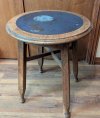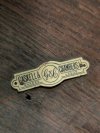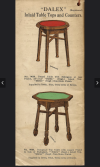-
Welcome to this forum . We are a worldwide group with a common interest in Birmingham and its history. While here, please follow a few simple rules. We ask that you respect other members, thank those who have helped you and please keep your contributions on-topic with the thread.
We do hope you enjoy your visit. BHF Admin Team
You are using an out of date browser. It may not display this or other websites correctly.
You should upgrade or use an alternative browser.
You should upgrade or use an alternative browser.
Hi Ray
you are quite correct to say that GC Was in Consstution street which they was most indeed
and prior to that before the war years they occupied a very large building on the corner of bordesly street
and along the new cannal street digbeth and its the Asian cash and carry i think they call it A S wholsalers today
this is before the war years whn they got bombed Astonian ,,, Alan,,,
you are quite correct to say that GC Was in Consstution street which they was most indeed
and prior to that before the war years they occupied a very large building on the corner of bordesly street
and along the new cannal street digbeth and its the Asian cash and carry i think they call it A S wholsalers today
this is before the war years whn they got bombed Astonian ,,, Alan,,,
Gaskell & Chambers interest me as they originally took over the premises of the Yates family who had occupied 37-43 Coleshill Street from as early as the early 1800’s. The patriarch of the family Thomas Yates was a die sinker from around 1788. His grandsons included the Mayor of Birmingham Edwin Yates, and the others boys were primarily pewterers. Thomas junior made spoons and whistles, and James specialised in Bar fitting equipment, beer machines. This was acquired by William Perks of Dale End in the late 19th century, and eventually the whole complex fell into the hand of Gaskell & Chambers.
Heartland
master brummie
Looking at all these reports, there is little mention of the word beer engine. The mechanism for the hand pull, so much a feature of the real ale public house, was called a beer engine, or liquor engine, depending on the alcohol dispensed.
Gaskell moved their premises to Drayton Road in Shirley, has any body any memories of that works
Gaskell moved their premises to Drayton Road in Shirley, has any body any memories of that works
Radiorails
master brummie
Post 1 of this thread:
https://birminghamhistory.co.uk/forum/index.php?threads/gaskell-chambers.4339/
which pre-dates this one, mentions beer engines. It looks like two threads on G&C.
Good pictures of the engines here:
https://www.gracesguide.co.uk/Gaskell_and_Chambers
https://birminghamhistory.co.uk/forum/index.php?threads/gaskell-chambers.4339/
which pre-dates this one, mentions beer engines. It looks like two threads on G&C.
Good pictures of the engines here:
https://www.gracesguide.co.uk/Gaskell_and_Chambers
Welshbrummy
New Member
He's my Great Great Uncle, too! On my mother's side. Sir Cornelius married my granny's (my mum's mother's) aunt. Don't know much: my mum (who died in 2000) told me 'Uncle Corny' was knighted for services to industry, and, I seem to remember, he lost money in South African (diamond?) mines (which flooded), or some such venture. He helped my granny by setting her up with an off-licence when she fell on hard times. But I'd like to know more... Steve JonesHi can anyone shed any light on the origins of Gaskell & Chambers? My gerat, great uncle, Sir Cornelius Chambers, was Chairman of G&C in the early 20th century. I have evidence of him as a clerk in 1891, but assume that the company existed prior to Cornelius, and how he came to be chairman. And who was Gaskell? I have made enquiries to the modern day company but they don't appear to have any historical records.
Any information anyone can pass on would be greatly appreciated!
Kungfufighter
New Member
I worked for Gaskell and Chambers (southern) from 1961-1969 first as a Joiner then as a Joinery Setter-Out,We had a Pewtering dept, we used to strip Pewter sub-tops and sinks fit stainless steel ones and cover the tops with Formica.Used to work with some of the Lads from Brum ,They came down when we could not cope with the workload.I see real pigs-ears of Bars these days.
Radiorails
master brummie
Were Gaskell and Chambers the only Birmingham manufacturers of these things. I would doubt it.
mw0njm.
A Brummie Dude
Sprayerman
New Member
When we used to frequent the Great Dorset Steam Fair in the early 2000's one year found a single G&C beer engine assembly, looking essentially like the drawing in post #69 above, with a couple of similar looking looking pumps, one is G&C plated, the other isn't, on one of the stands within the 'autojumble' area. I eventually managed to get it all at a very decent price towards the end of the show when the vendor was just desperate to get rid of it to save taking home. Fascinating equipment, so well made. Used one as a water lifter pump for a few years on a small allotment to save using tap water.
Chris47hopkins
New Member
Does anyone remember Howard Hopkins, Master pewterer for G & C for many years.
Richard Dye
master brummie
Welcome to the Forum Sprayerman! A great place with wonderful folks and information, enjoy!When we used to frequent the Great Dorset Steam Fair in the early 2000's one year found a single G&C beer engine assembly, looking essentially like the drawing in post #69 above, with a couple of similar looking looking pumps, one is G&C plated, the other isn't, on one of the stands within the 'autojumble' area. I eventually managed to get it all at a very decent price towards the end of the show when the vendor was just desperate to get rid of it to save taking home. Fascinating equipment, so well made. Used one as a water lifter pump for a few years on a small allotment to save using tap water.
Neilperkins
New Member
My dads company, wood and perkins used to make them in Cato street north in nechells…Were Gaskell and Chambers the only Birmingham manufacturers of these things. I would doubt it.
My husband had Gaskell & Chambers OPTIC PEARL 6 stamped 566565 - I have no idea where/when he acquired or anything about it. Can anyone tell me 1) the significance of the numbers 566565 2) the likely date of manufacture 3) to what does the number 6 relate?
Any info gratefully received Judith54
Post moved to main G & C thread
Any info gratefully received Judith54
Post moved to main G & C thread
Last edited by a moderator:
Hewgo_Weaving
New Member
Hey everyone!
My family has this Gaskell & Chambers Dalex inlaid table. It has some water damage and we want to restore or replace the inlay, but am having trouble identifying the material.
Some antique websites say the material is Dalex, but from what I can tell, Dalex is just the branding of items that originally were made at the Dalex Works in Birmingham.
Any idea where to look? I have this page from an old catalogue, but don't know where I'd find the registration to find the details on the material (my early guess was bakelite, but it fails all of the tests)



My family has this Gaskell & Chambers Dalex inlaid table. It has some water damage and we want to restore or replace the inlay, but am having trouble identifying the material.
Some antique websites say the material is Dalex, but from what I can tell, Dalex is just the branding of items that originally were made at the Dalex Works in Birmingham.
Any idea where to look? I have this page from an old catalogue, but don't know where I'd find the registration to find the details on the material (my early guess was bakelite, but it fails all of the tests)



Hi and welcome.Hey everyone!
My family has this Gaskell & Chambers Dalex inlaid table. It has some water damage and we want to restore or replace the inlay, but am having trouble identifying the material.
Some antique websites say the material is Dalex, but from what I can tell, Dalex is just the branding of items that originally were made at the Dalex Works in Birmingham.
Any idea where to look? I have this page from an old catalogue, but don't know where I'd find the registration to find the details on the material (my early guess was bakelite, but it fails all of the tests)
View attachment 196882View attachment 196883View attachment 196884
That’s a nice table but Dalex is a new one to me. I am wondering if Dalex is a brand name for bar equipment and not a material.
It did also cross my mind that it may be a type of Formica composite type material.
Is it hard or soft, or like plastic or rubber?
If it were me, I would try least intrusive first. Try cleaning with some mild soap and water, testing a small area first. I am thinking if it is water damage or something else like heat that’s marked it. I would be surprised if it is water damage on a bar room table, they had to withstand beers, wine and spirits
Hewgo_Weaving
New Member
Thanks!Hi and welcome.
That’s a nice table but Dalex is a new one to me. I am wondering if Dalex is a brand name for bar equipment and not a material.
It did also cross my mind that it may be a type of Formica composite type material.
Is it hard or soft, or like plastic or rubber?
If it were me, I would try least intrusive first. Try cleaning with some mild soap and water, testing a small area first. I am thinking if it is water damage or something else like heat that’s marked it. I would be surprised if it is water damage on a bar room table, they had to withstand beers, wine and spirits
Yeah, Dalex comes from several different G&C products that were registered originally at the Dale End Works in Birmingham, doesn't seem to be a material (despite what quick searches would claim). I know for a fact that the main hint was that the "Dalex" Beer Engine from G&C didn't have any of the same material.
It kind of feels like a plastic. It's hard, and dents. It's a dark blue that turns a bit more saturated with a water cleaning. The big spot is water damage, and seems to have seeped in.
I'm honestly thinking that the inlay, whatever material, might be painted. But I really would love an expert to swoop in and save me.
I did think about what materials synthetic or other were available when it was made, I am assuming 1930’s? Also am curious why it had absorbed water and stained.
Am I seeing a tiny white fleck pattern on the surface too?
If this were my piece, I would think quite carefully about what you want to end up with.
I really like it. It has the look of something that’s factory made mass produced with a lovely simplistic styling. There were possibly thousands made and now most of them don’t exist anymore, so it also had a rarity value too. Furniture with makers marks on are also super interesting, it has a lovely connection with the past.
Restoring the wood parts is relatively straightforward, but the top may prove challenging. Dealing with white watermarks on polished furniture is quite simple. Put some methylated spirit on and put a match to it. It does need some experience to do this, but it works remarkably well. Another possibility could be a fine abrasive paste and see if it would polish out. Again, experience is required.
If this was mine, I would think very carefully about what you want to end up with. Do you want a new looking 1930’s table?
I take the line of it is of critical importance that any patina of age, the craftsmanship, the archaeological interest, and the plain sense of connection with the past through the age of the materials should not be lost.
Am I seeing a tiny white fleck pattern on the surface too?
If this were my piece, I would think quite carefully about what you want to end up with.
I really like it. It has the look of something that’s factory made mass produced with a lovely simplistic styling. There were possibly thousands made and now most of them don’t exist anymore, so it also had a rarity value too. Furniture with makers marks on are also super interesting, it has a lovely connection with the past.
Restoring the wood parts is relatively straightforward, but the top may prove challenging. Dealing with white watermarks on polished furniture is quite simple. Put some methylated spirit on and put a match to it. It does need some experience to do this, but it works remarkably well. Another possibility could be a fine abrasive paste and see if it would polish out. Again, experience is required.
If this was mine, I would think very carefully about what you want to end up with. Do you want a new looking 1930’s table?
I take the line of it is of critical importance that any patina of age, the craftsmanship, the archaeological interest, and the plain sense of connection with the past through the age of the materials should not be lost.
superdad3
master brummie
Samuel Mason Ltd.
Samuel Mason used to live in St Agnes Road, Moseley.
Samuel Mason Ltd. was founded in Birmingham as Mason and Lawley in the early 1800s. The firm started as makers of balance cocks for clock movements, and later specialized in bar equipment. It was taken over by Gaskell and Chambers around 1925 though the brand name was retained.
His son, Samuel George Herbert Mason was originally apprenticed in the family brass foundry but left in 1907 to become an actor and had a long career in theatre and film. He saw active service in World War I in the Warwicks and the Machine Gun Corp and was awarded the Military Cross for bravery.
Samuel Mason used to live in St Agnes Road, Moseley.
Samuel Mason Ltd. was founded in Birmingham as Mason and Lawley in the early 1800s. The firm started as makers of balance cocks for clock movements, and later specialized in bar equipment. It was taken over by Gaskell and Chambers around 1925 though the brand name was retained.
His son, Samuel George Herbert Mason was originally apprenticed in the family brass foundry but left in 1907 to become an actor and had a long career in theatre and film. He saw active service in World War I in the Warwicks and the Machine Gun Corp and was awarded the Military Cross for bravery.
pjmburns
master brummie
"Dalex" is a trade mark. Not sure if that is what it refers to here or if these tables are called that because of the factory.
Click on list of goods.
Clas 18 use is in imitation leather - is this the material used for the inlay?
Click on list of goods.
Clas 18 use is in imitation leather - is this the material used for the inlay?
Richard Dye
master brummie
Not sure about the mentholated sprit because I have no experience with that approach, but I do like the idea of using the fine grit sanding approach. I think that Morts council is very appropriate, thinking carefully as to what do you want to end up with?I did think about what materials synthetic or other were available when it was made, I am assuming 1930’s? Also am curious why it had absorbed water and stained.
Am I seeing a tiny white fleck pattern on the surface too?
If this were my piece, I would think quite carefully about what you want to end up with.
I really like it. It has the look of something that’s factory made mass produced with a lovely simplistic styling. There were possibly thousands made and now most of them don’t exist anymore, so it also had a rarity value too. Furniture with makers marks on are also super interesting, it has a lovely connection with the past.
Restoring the wood parts is relatively straightforward, but the top may prove challenging. Dealing with white watermarks on polished furniture is quite simple. Put some methylated spirit on and put a match to it. It does need some experience to do this, but it works remarkably well. Another possibility could be a fine abrasive paste and see if it would polish out. Again, experience is required.
If this was mine, I would think very carefully about what you want to end up with. Do you want a new looking 1930’s table?
I take the line of it is of critical importance that any patina of age, the craftsmanship, the archaeological interest, and the plain sense of connection with the past through the age of the materials should not be lost.
Good luck!
Richard Dye
master brummie
Yes, I saw that; looked like an early version of a semi synthetic material used on relatively high volume furniture manufacturing. The name coming from their address Dale End. Then nothing!"Dalex" is a trade mark. Not sure if that is what it refers to here or if these tables are called that because of the factory.
Click on list of goods.
Clas 18 use is in imitation leather - is this the material used for the inlay?



